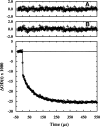Probing the folding intermediate of Rd-apocyt b562 by protein engineering and infrared T-jump
- PMID: 17473017
- PMCID: PMC2206668
- DOI: 10.1110/ps.062505607
Probing the folding intermediate of Rd-apocyt b562 by protein engineering and infrared T-jump
Abstract
Small proteins often fold in an apparent two-state manner with the absence of detectable early-folding intermediates. Recently, using native-state hydrogen exchange, intermediates that exist after the rate-limiting transition state have been identified for several proteins. However, little is known about the folding kinetics from these post-transition intermediates to their corresponding native states. Herein, we have used protein engineering and a laser-induced temperature-jump (T-jump) technique to investigate this issue and have applied it to Rd-apocyt b(562) , a four-helix bundle protein. Previously, it has been shown that Rd-apocyt b(562) folds via an on-pathway hidden intermediate, which has only the N-terminal helix unfolded. In the present study, a double mutation (V16G/I17A) in the N-terminal helix of Rd-apocyt b(562) was made to further increase the relative population of this intermediate state at high temperature by selectively destabilizing the native state. In the circular dichroism thermal melting experiment, this mutant showed apparent two-state folding behavior. However, in the T-jump experiment, two kinetic phases were observed. Therefore, these results are in agreement with the idea that a folding intermediate is populated on the folding pathway of Rd-apocyt b(562) . Moreover, it was found that the exponential growth rate of the native state from this intermediate state is roughly (25 microsec)(-1) at 65 degrees C.
Figures







Similar articles
-
Design and folding of a multidomain protein.Biochemistry. 2005 Sep 13;44(36):12107-12. doi: 10.1021/bi050785r. Biochemistry. 2005. PMID: 16142908
-
An on-pathway hidden intermediate and the early rate-limiting transition state of Rd-apocytochrome b562 characterized by protein engineering.J Mol Biol. 2005 Sep 30;352(4):757-64. doi: 10.1016/j.jmb.2005.07.057. J Mol Biol. 2005. PMID: 16125200
-
An 15N NMR spin relaxation dispersion study of the folding of a pair of engineered mutants of apocytochrome b562.J Am Chem Soc. 2005 Apr 13;127(14):5066-72. doi: 10.1021/ja042560u. J Am Chem Soc. 2005. PMID: 15810841
-
Specific non-native hydrophobic interactions in a hidden folding intermediate: implications for protein folding.Biochemistry. 2003 Nov 4;42(43):12461-5. doi: 10.1021/bi035561s. Biochemistry. 2003. PMID: 14580191
-
Hidden intermediates and levinthal paradox in the folding of small proteins.Biochem Biophys Res Commun. 2003 Jun 13;305(4):785-8. doi: 10.1016/s0006-291x(03)00800-3. Biochem Biophys Res Commun. 2003. PMID: 12767898 Review.
Cited by
-
Network representation of conformational transitions between hidden intermediates of Rd-apocytochrome b562.J Chem Phys. 2015 Oct 7;143(13):135101. doi: 10.1063/1.4931921. J Chem Phys. 2015. PMID: 26450332 Free PMC article.
-
The folding of single domain proteins--have we reached a consensus?Curr Opin Struct Biol. 2011 Feb;21(1):12-24. doi: 10.1016/j.sbi.2010.11.002. Epub 2010 Dec 6. Curr Opin Struct Biol. 2011. PMID: 21144739 Free PMC article. Review.
-
Kinetically trapped metastable intermediate of a disulfide-deficient mutant of the starch-binding domain of glucoamylase.Protein Sci. 2009 Aug;18(8):1715-23. doi: 10.1002/pro.188. Protein Sci. 2009. PMID: 19530230 Free PMC article.
-
Unfolding cytochromes c-b562 and Rd apo b562.J Inorg Biochem. 2020 Oct;211:111209. doi: 10.1016/j.jinorgbio.2020.111209. Epub 2020 Aug 10. J Inorg Biochem. 2020. PMID: 32818710 Free PMC article.
-
Using VIPT-jump to distinguish between different folding mechanisms: application to BBL and a Trpzip.J Am Chem Soc. 2013 May 22;135(20):7668-73. doi: 10.1021/ja401473m. Epub 2013 May 14. J Am Chem Soc. 2013. PMID: 23642153 Free PMC article.
References
-
- Bai Y. 2003. Hidden intermediates and Levinthal paradox in the folding of small proteins. Biochem. Biophys. Res. Commun. 305: 785–788. - PubMed
-
- Bryngelson J.D., Onuchic, J.N., Socci, N.D., and Wolynes, P.G. 1995. Funnels, pathways, and the energy landscape of protein folding: A synthesis. Proteins 21: 167–195. - PubMed
-
- Chu R., Pei, W., Takei, J., and Bai, Y. 2002a. Relationship between the native-state hydrogen exchange and folding pathways of a four-helix bundle protein. Biochemistry 41: 7998–8003. - PubMed
Publication types
MeSH terms
Substances
Grants and funding
LinkOut - more resources
Full Text Sources
Miscellaneous

